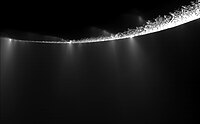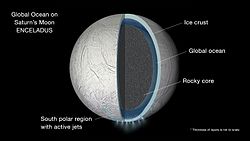



Enceladus Life Signatures and Habitability (ELSAH) is an astrobiology concept mission proposed in 2017 to NASA's New Frontiers program to send a spacecraft to Enceladus to search for biosignatures and assess its habitability.[1][2] The Principal Investigator is Christopher P. McKay, an astrobiologist at NASA Ames Research Center,[3] and the managing NASA center is Goddard Space Flight Center. No details of the mission have been made public, but observers speculate that it would be a plume-sampling orbiter mission.[4]
The two finalists, announced on 20 December 2017, are Dragonfly to Titan, and CAESAR (Comet Astrobiology Exploration Sample Return) which is a sample-return mission from comet 67P/Churyumov–Gerasimenko.[5]
Although ELSAH was not selected for launch in this instance, it received technology development funds to prepare it for future mission competitions.[6] The funds are meant to develop techniques that limit spacecraft contamination and thereby enable life detection measurements on cost-capped missions.[6]
|
| |||||||
|---|---|---|---|---|---|---|---|
| Events and objects |
| ||||||
| Signals of interest |
| ||||||
| Life in the Universe |
| ||||||
| Planetary habitability |
| ||||||
| Space missions |
| ||||||
| Interstellar communication |
| ||||||
| Types of alleged extraterrestrial beings |
| ||||||
| Hypotheses |
| ||||||
| Fermi paradox solutions |
| ||||||
| Related topics |
| ||||||
|
| ||||||||||||||||||
|---|---|---|---|---|---|---|---|---|---|---|---|---|---|---|---|---|---|---|
| ||||||||||||||||||
| ||||||||||||||||||
| ||||||||||||||||||
| ||||||||||||||||||
|
| |||||||||
|---|---|---|---|---|---|---|---|---|---|
| Past |
| ||||||||
| Planned |
| ||||||||
| Proposed |
| ||||||||
| |||||||||